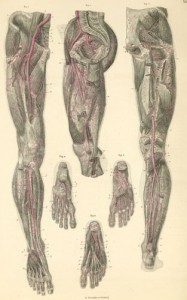 Pressing down on the inner foot activates the muscles of the inner upper thighs.
Pressing down on the inner foot activates the muscles of the inner upper thighs.
Accessing the deep core of the body, where all the good action is, requires this type of movement through the inner extremities.
The issue is that people tend to bear the body’s weight on the outer portions of the body instead of the inner:
- We wear out our shoes on the outside.
- We tend to be very tight in the IT band of the outer hip.
- Watching students in Down Dog in yoga class, I find that most students bear the weight of the arms in the outer heel of the palm.
Grounding weight on the inner foot helps to align and use the psoas major muscle to its mechanical advantage.
Accessing the advantage requires that the psoas be situated on the back half of the body at its top and bottom.
When the psoas lives in the backplane of the body it can be used like a pulley essentially holding the spine up above the pelvis.
The outer foot pulls the psoas towards the front of the body, tucking the pelvis along the way, while the inner foot allows the inner thighs to tone and move slightly backward.
It is pretty easy to feel the difference that bearing weight on the inside and outside of the foot makes:
- Come to stand in your natural posture.
- Roll weight to the outside of the foot feeling the outer thighs. They should tone when you do that.
- Take your thighs back, untucking the pelvis, and roll to the inside of the foot. The inner thighs should activate more than the outer thighs.
Weight on the outer foot adds up to a tight IT Band.
Weight on the inner foot gives your inner thighs the chance to develop the tone required to align the psoas.
